Case Study: DTA's Processes, Organizational Structure, and Redesign
VerifiedAdded on 2023/06/04
|8
|1602
|283
Case Study
AI Summary
This case study examines the Department of Traditional Assistance (DTA) and its attempt to modernize its state social service system through an information systems redesign project. The report provides a background of the DTA, detailing its functional units, processes, organizational structure, and the reasons behind the redesign initiative. The project aimed to automate welfare benefits processing, improve communication between social workers and clients, and modernize the IT infrastructure. However, the project ultimately failed due to a lack of feasibility studies, poor budgeting, scheduling, and staffing issues. The study concludes that the DTA's experience highlights the challenges and risks associated with large-scale automation projects in social service agencies, emphasizing the need for thorough planning, stakeholder involvement, and ongoing oversight to ensure success. The case also raises questions about the department's ability to maintain the new system and adapt to future changes.
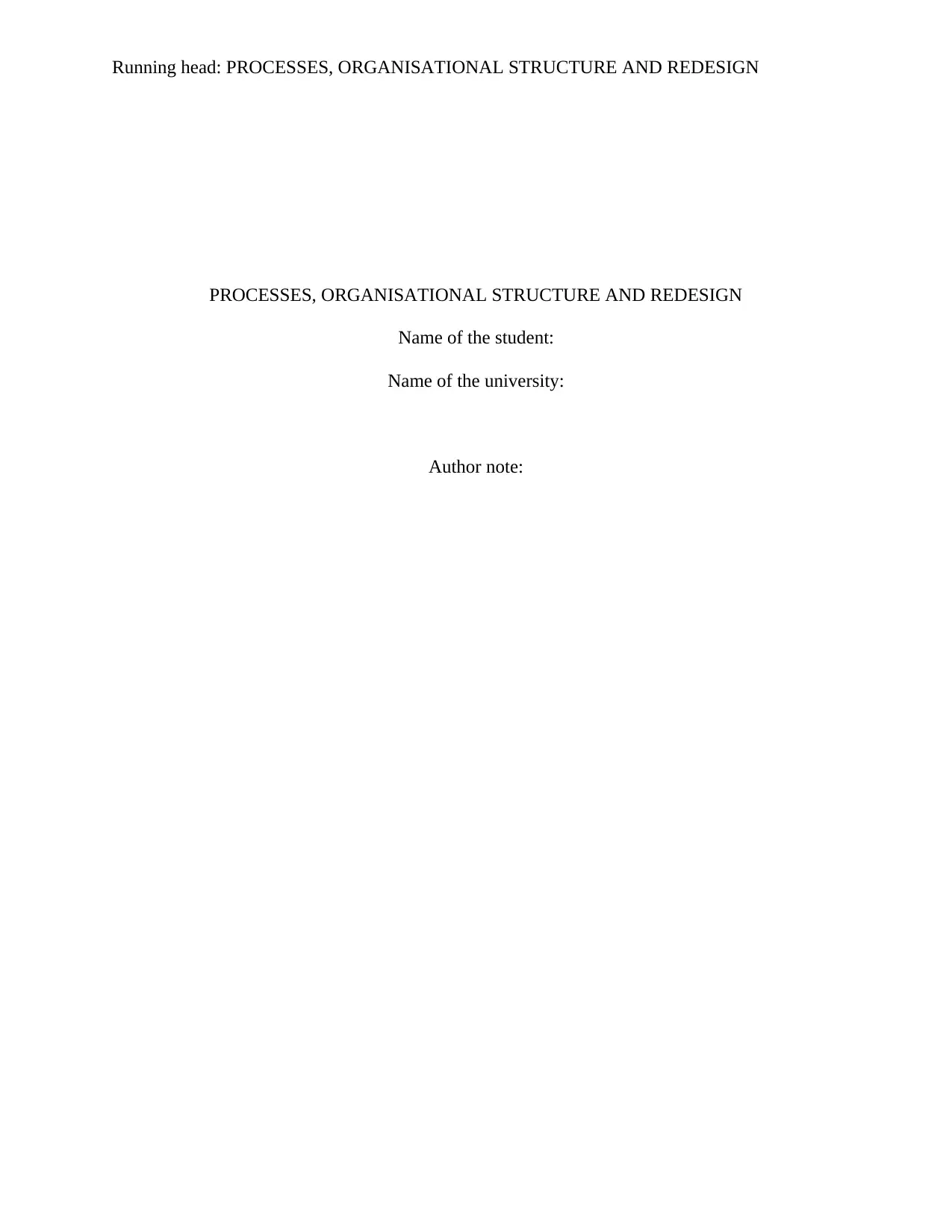
Running head: PROCESSES, ORGANISATIONAL STRUCTURE AND REDESIGN
PROCESSES, ORGANISATIONAL STRUCTURE AND REDESIGN
Name of the student:
Name of the university:
Author note:
PROCESSES, ORGANISATIONAL STRUCTURE AND REDESIGN
Name of the student:
Name of the university:
Author note:
Secure Best Marks with AI Grader
Need help grading? Try our AI Grader for instant feedback on your assignments.
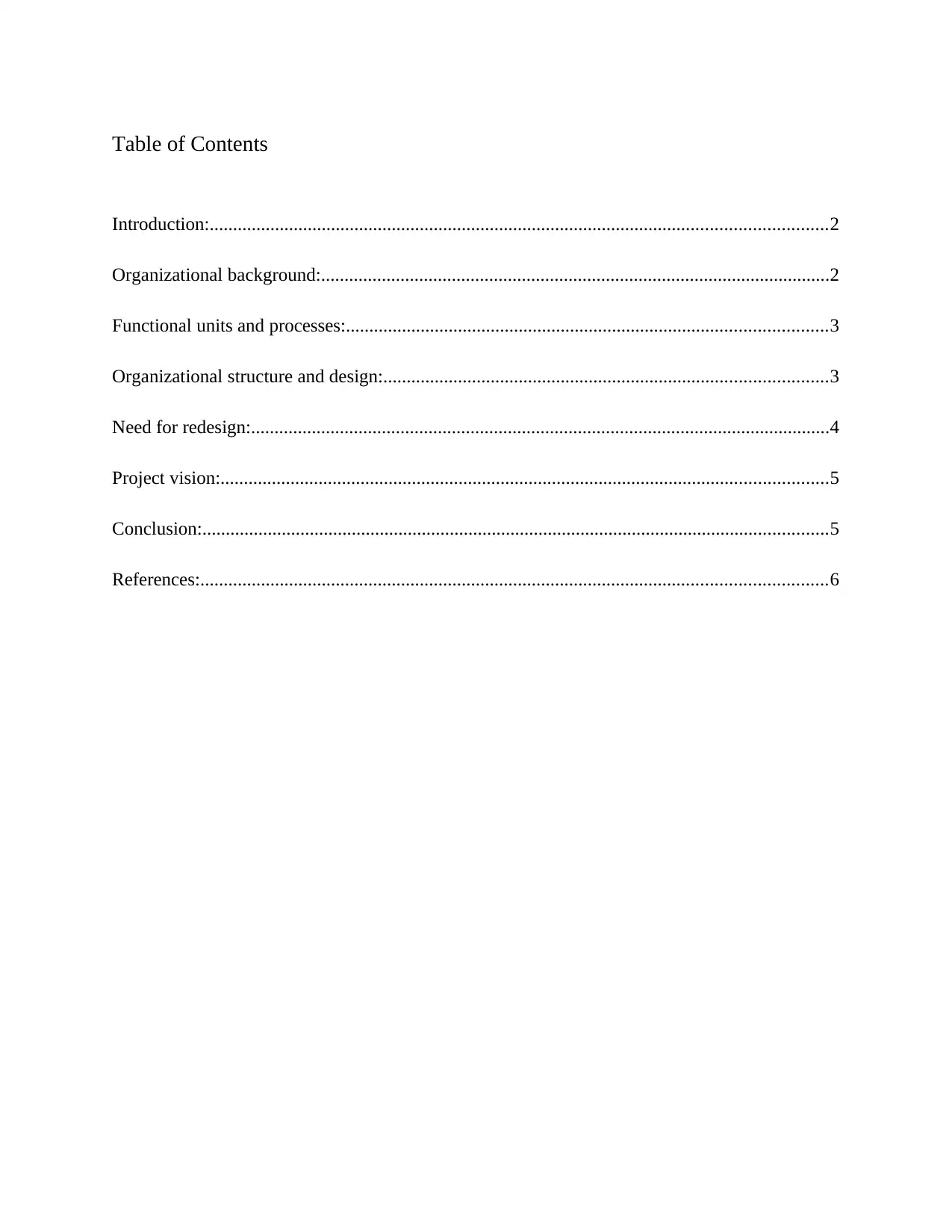
Table of Contents
Introduction:....................................................................................................................................2
Organizational background:.............................................................................................................2
Functional units and processes:.......................................................................................................3
Organizational structure and design:...............................................................................................3
Need for redesign:............................................................................................................................4
Project vision:..................................................................................................................................5
Conclusion:......................................................................................................................................5
References:......................................................................................................................................6
Introduction:....................................................................................................................................2
Organizational background:.............................................................................................................2
Functional units and processes:.......................................................................................................3
Organizational structure and design:...............................................................................................3
Need for redesign:............................................................................................................................4
Project vision:..................................................................................................................................5
Conclusion:......................................................................................................................................5
References:......................................................................................................................................6
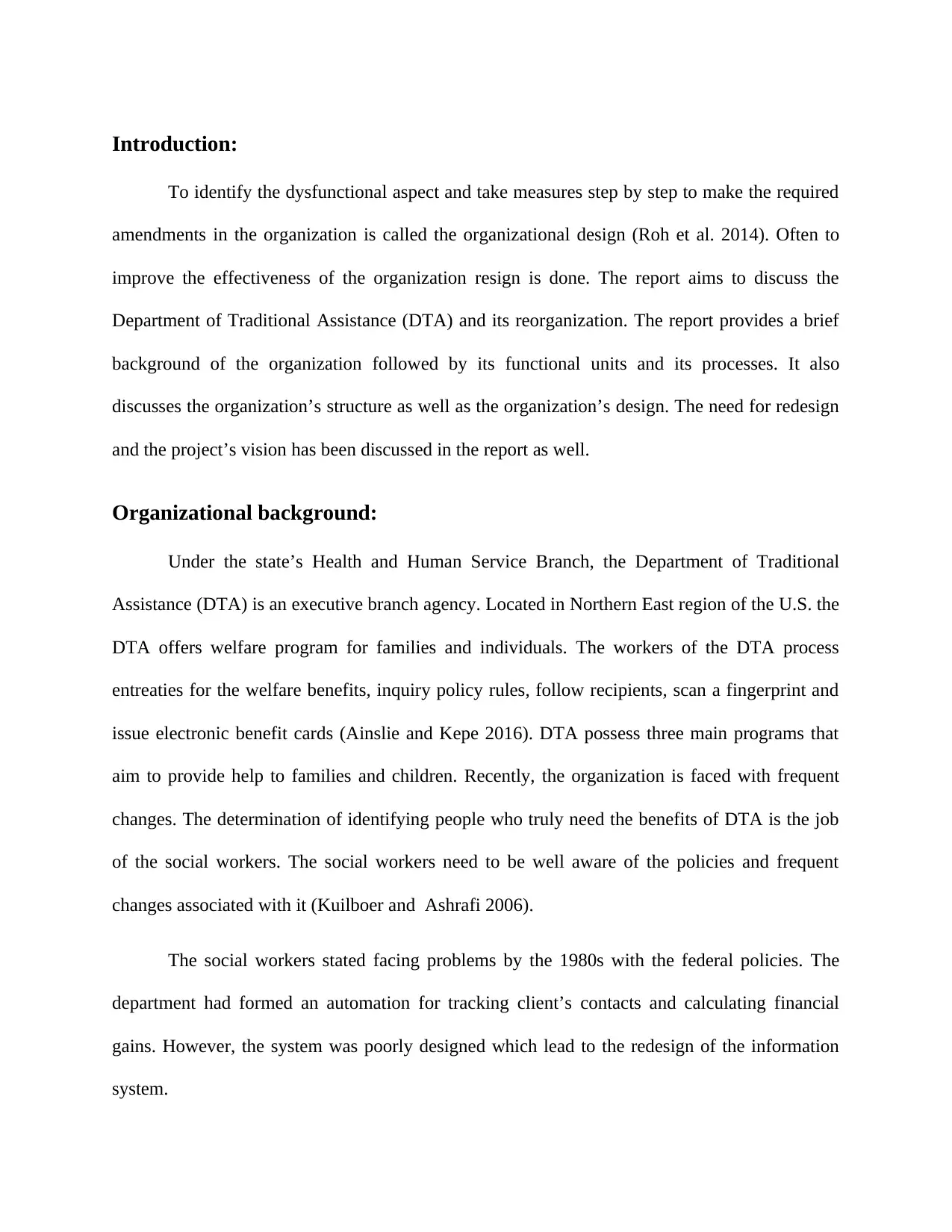
Introduction:
To identify the dysfunctional aspect and take measures step by step to make the required
amendments in the organization is called the organizational design (Roh et al. 2014). Often to
improve the effectiveness of the organization resign is done. The report aims to discuss the
Department of Traditional Assistance (DTA) and its reorganization. The report provides a brief
background of the organization followed by its functional units and its processes. It also
discusses the organization’s structure as well as the organization’s design. The need for redesign
and the project’s vision has been discussed in the report as well.
Organizational background:
Under the state’s Health and Human Service Branch, the Department of Traditional
Assistance (DTA) is an executive branch agency. Located in Northern East region of the U.S. the
DTA offers welfare program for families and individuals. The workers of the DTA process
entreaties for the welfare benefits, inquiry policy rules, follow recipients, scan a fingerprint and
issue electronic benefit cards (Ainslie and Kepe 2016). DTA possess three main programs that
aim to provide help to families and children. Recently, the organization is faced with frequent
changes. The determination of identifying people who truly need the benefits of DTA is the job
of the social workers. The social workers need to be well aware of the policies and frequent
changes associated with it (Kuilboer and Ashrafi 2006).
The social workers stated facing problems by the 1980s with the federal policies. The
department had formed an automation for tracking client’s contacts and calculating financial
gains. However, the system was poorly designed which lead to the redesign of the information
system.
To identify the dysfunctional aspect and take measures step by step to make the required
amendments in the organization is called the organizational design (Roh et al. 2014). Often to
improve the effectiveness of the organization resign is done. The report aims to discuss the
Department of Traditional Assistance (DTA) and its reorganization. The report provides a brief
background of the organization followed by its functional units and its processes. It also
discusses the organization’s structure as well as the organization’s design. The need for redesign
and the project’s vision has been discussed in the report as well.
Organizational background:
Under the state’s Health and Human Service Branch, the Department of Traditional
Assistance (DTA) is an executive branch agency. Located in Northern East region of the U.S. the
DTA offers welfare program for families and individuals. The workers of the DTA process
entreaties for the welfare benefits, inquiry policy rules, follow recipients, scan a fingerprint and
issue electronic benefit cards (Ainslie and Kepe 2016). DTA possess three main programs that
aim to provide help to families and children. Recently, the organization is faced with frequent
changes. The determination of identifying people who truly need the benefits of DTA is the job
of the social workers. The social workers need to be well aware of the policies and frequent
changes associated with it (Kuilboer and Ashrafi 2006).
The social workers stated facing problems by the 1980s with the federal policies. The
department had formed an automation for tracking client’s contacts and calculating financial
gains. However, the system was poorly designed which lead to the redesign of the information
system.
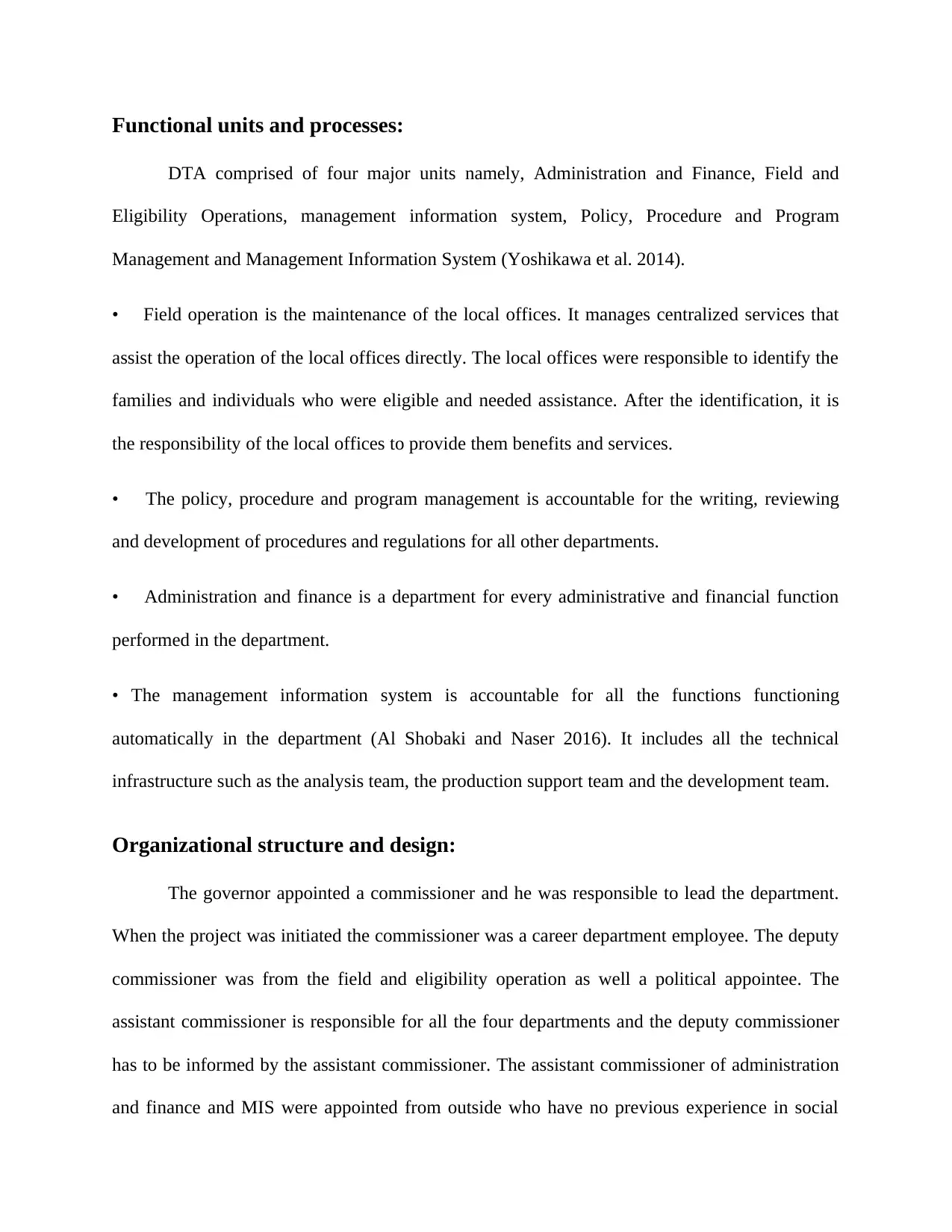
Functional units and processes:
DTA comprised of four major units namely, Administration and Finance, Field and
Eligibility Operations, management information system, Policy, Procedure and Program
Management and Management Information System (Yoshikawa et al. 2014).
• Field operation is the maintenance of the local offices. It manages centralized services that
assist the operation of the local offices directly. The local offices were responsible to identify the
families and individuals who were eligible and needed assistance. After the identification, it is
the responsibility of the local offices to provide them benefits and services.
• The policy, procedure and program management is accountable for the writing, reviewing
and development of procedures and regulations for all other departments.
• Administration and finance is a department for every administrative and financial function
performed in the department.
• The management information system is accountable for all the functions functioning
automatically in the department (Al Shobaki and Naser 2016). It includes all the technical
infrastructure such as the analysis team, the production support team and the development team.
Organizational structure and design:
The governor appointed a commissioner and he was responsible to lead the department.
When the project was initiated the commissioner was a career department employee. The deputy
commissioner was from the field and eligibility operation as well a political appointee. The
assistant commissioner is responsible for all the four departments and the deputy commissioner
has to be informed by the assistant commissioner. The assistant commissioner of administration
and finance and MIS were appointed from outside who have no previous experience in social
DTA comprised of four major units namely, Administration and Finance, Field and
Eligibility Operations, management information system, Policy, Procedure and Program
Management and Management Information System (Yoshikawa et al. 2014).
• Field operation is the maintenance of the local offices. It manages centralized services that
assist the operation of the local offices directly. The local offices were responsible to identify the
families and individuals who were eligible and needed assistance. After the identification, it is
the responsibility of the local offices to provide them benefits and services.
• The policy, procedure and program management is accountable for the writing, reviewing
and development of procedures and regulations for all other departments.
• Administration and finance is a department for every administrative and financial function
performed in the department.
• The management information system is accountable for all the functions functioning
automatically in the department (Al Shobaki and Naser 2016). It includes all the technical
infrastructure such as the analysis team, the production support team and the development team.
Organizational structure and design:
The governor appointed a commissioner and he was responsible to lead the department.
When the project was initiated the commissioner was a career department employee. The deputy
commissioner was from the field and eligibility operation as well a political appointee. The
assistant commissioner is responsible for all the four departments and the deputy commissioner
has to be informed by the assistant commissioner. The assistant commissioner of administration
and finance and MIS were appointed from outside who have no previous experience in social
Secure Best Marks with AI Grader
Need help grading? Try our AI Grader for instant feedback on your assignments.
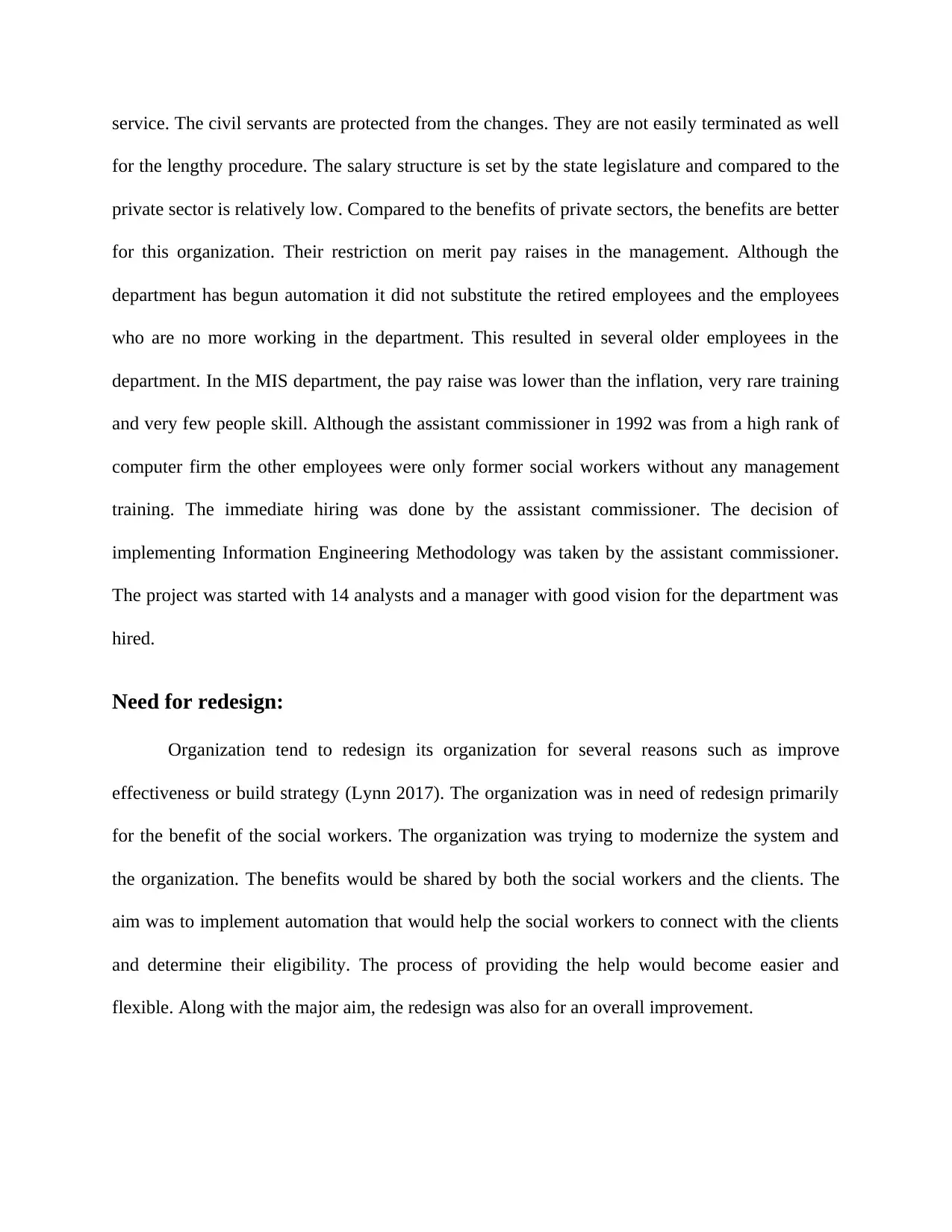
service. The civil servants are protected from the changes. They are not easily terminated as well
for the lengthy procedure. The salary structure is set by the state legislature and compared to the
private sector is relatively low. Compared to the benefits of private sectors, the benefits are better
for this organization. Their restriction on merit pay raises in the management. Although the
department has begun automation it did not substitute the retired employees and the employees
who are no more working in the department. This resulted in several older employees in the
department. In the MIS department, the pay raise was lower than the inflation, very rare training
and very few people skill. Although the assistant commissioner in 1992 was from a high rank of
computer firm the other employees were only former social workers without any management
training. The immediate hiring was done by the assistant commissioner. The decision of
implementing Information Engineering Methodology was taken by the assistant commissioner.
The project was started with 14 analysts and a manager with good vision for the department was
hired.
Need for redesign:
Organization tend to redesign its organization for several reasons such as improve
effectiveness or build strategy (Lynn 2017). The organization was in need of redesign primarily
for the benefit of the social workers. The organization was trying to modernize the system and
the organization. The benefits would be shared by both the social workers and the clients. The
aim was to implement automation that would help the social workers to connect with the clients
and determine their eligibility. The process of providing the help would become easier and
flexible. Along with the major aim, the redesign was also for an overall improvement.
for the lengthy procedure. The salary structure is set by the state legislature and compared to the
private sector is relatively low. Compared to the benefits of private sectors, the benefits are better
for this organization. Their restriction on merit pay raises in the management. Although the
department has begun automation it did not substitute the retired employees and the employees
who are no more working in the department. This resulted in several older employees in the
department. In the MIS department, the pay raise was lower than the inflation, very rare training
and very few people skill. Although the assistant commissioner in 1992 was from a high rank of
computer firm the other employees were only former social workers without any management
training. The immediate hiring was done by the assistant commissioner. The decision of
implementing Information Engineering Methodology was taken by the assistant commissioner.
The project was started with 14 analysts and a manager with good vision for the department was
hired.
Need for redesign:
Organization tend to redesign its organization for several reasons such as improve
effectiveness or build strategy (Lynn 2017). The organization was in need of redesign primarily
for the benefit of the social workers. The organization was trying to modernize the system and
the organization. The benefits would be shared by both the social workers and the clients. The
aim was to implement automation that would help the social workers to connect with the clients
and determine their eligibility. The process of providing the help would become easier and
flexible. Along with the major aim, the redesign was also for an overall improvement.
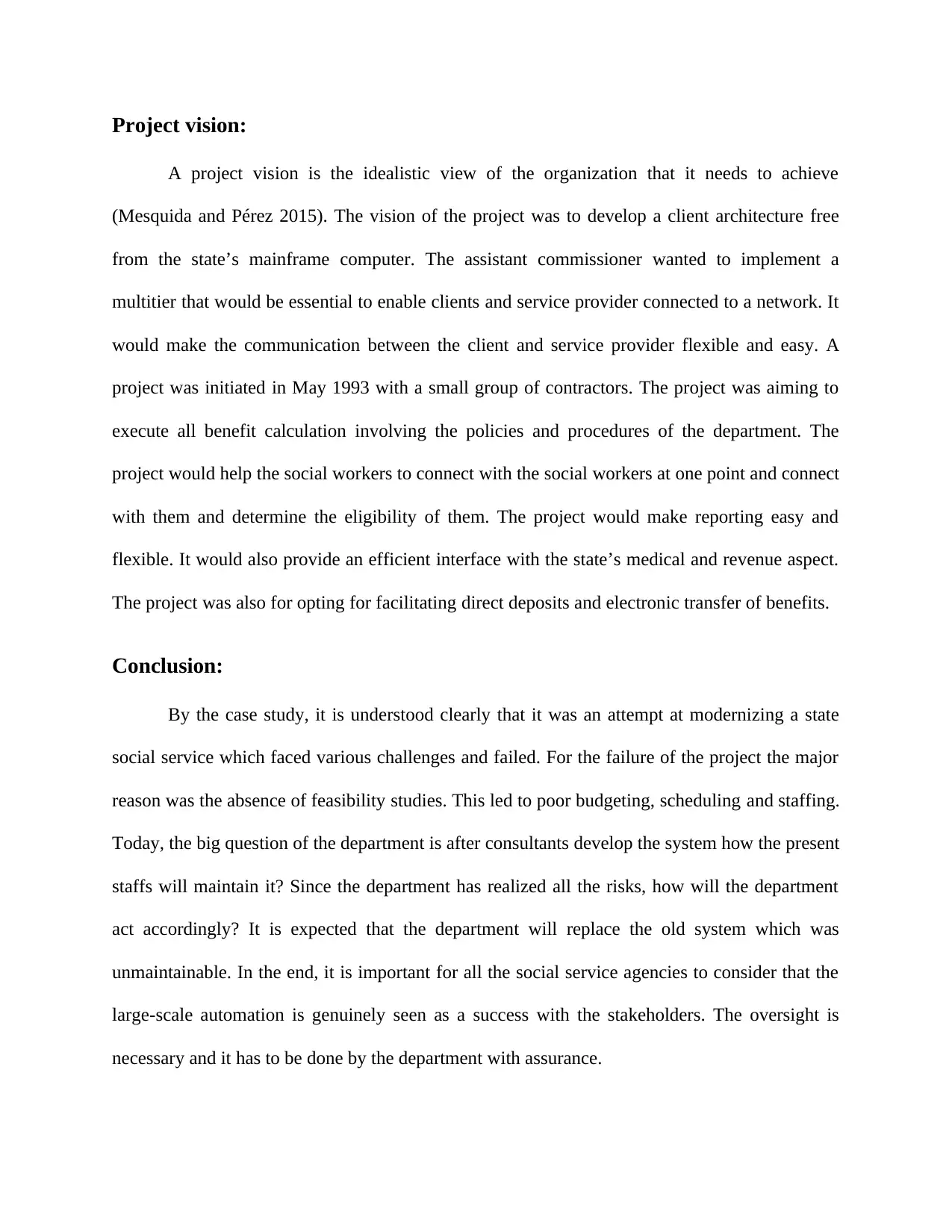
Project vision:
A project vision is the idealistic view of the organization that it needs to achieve
(Mesquida and Pérez 2015). The vision of the project was to develop a client architecture free
from the state’s mainframe computer. The assistant commissioner wanted to implement a
multitier that would be essential to enable clients and service provider connected to a network. It
would make the communication between the client and service provider flexible and easy. A
project was initiated in May 1993 with a small group of contractors. The project was aiming to
execute all benefit calculation involving the policies and procedures of the department. The
project would help the social workers to connect with the social workers at one point and connect
with them and determine the eligibility of them. The project would make reporting easy and
flexible. It would also provide an efficient interface with the state’s medical and revenue aspect.
The project was also for opting for facilitating direct deposits and electronic transfer of benefits.
Conclusion:
By the case study, it is understood clearly that it was an attempt at modernizing a state
social service which faced various challenges and failed. For the failure of the project the major
reason was the absence of feasibility studies. This led to poor budgeting, scheduling and staffing.
Today, the big question of the department is after consultants develop the system how the present
staffs will maintain it? Since the department has realized all the risks, how will the department
act accordingly? It is expected that the department will replace the old system which was
unmaintainable. In the end, it is important for all the social service agencies to consider that the
large-scale automation is genuinely seen as a success with the stakeholders. The oversight is
necessary and it has to be done by the department with assurance.
A project vision is the idealistic view of the organization that it needs to achieve
(Mesquida and Pérez 2015). The vision of the project was to develop a client architecture free
from the state’s mainframe computer. The assistant commissioner wanted to implement a
multitier that would be essential to enable clients and service provider connected to a network. It
would make the communication between the client and service provider flexible and easy. A
project was initiated in May 1993 with a small group of contractors. The project was aiming to
execute all benefit calculation involving the policies and procedures of the department. The
project would help the social workers to connect with the social workers at one point and connect
with them and determine the eligibility of them. The project would make reporting easy and
flexible. It would also provide an efficient interface with the state’s medical and revenue aspect.
The project was also for opting for facilitating direct deposits and electronic transfer of benefits.
Conclusion:
By the case study, it is understood clearly that it was an attempt at modernizing a state
social service which faced various challenges and failed. For the failure of the project the major
reason was the absence of feasibility studies. This led to poor budgeting, scheduling and staffing.
Today, the big question of the department is after consultants develop the system how the present
staffs will maintain it? Since the department has realized all the risks, how will the department
act accordingly? It is expected that the department will replace the old system which was
unmaintainable. In the end, it is important for all the social service agencies to consider that the
large-scale automation is genuinely seen as a success with the stakeholders. The oversight is
necessary and it has to be done by the department with assurance.
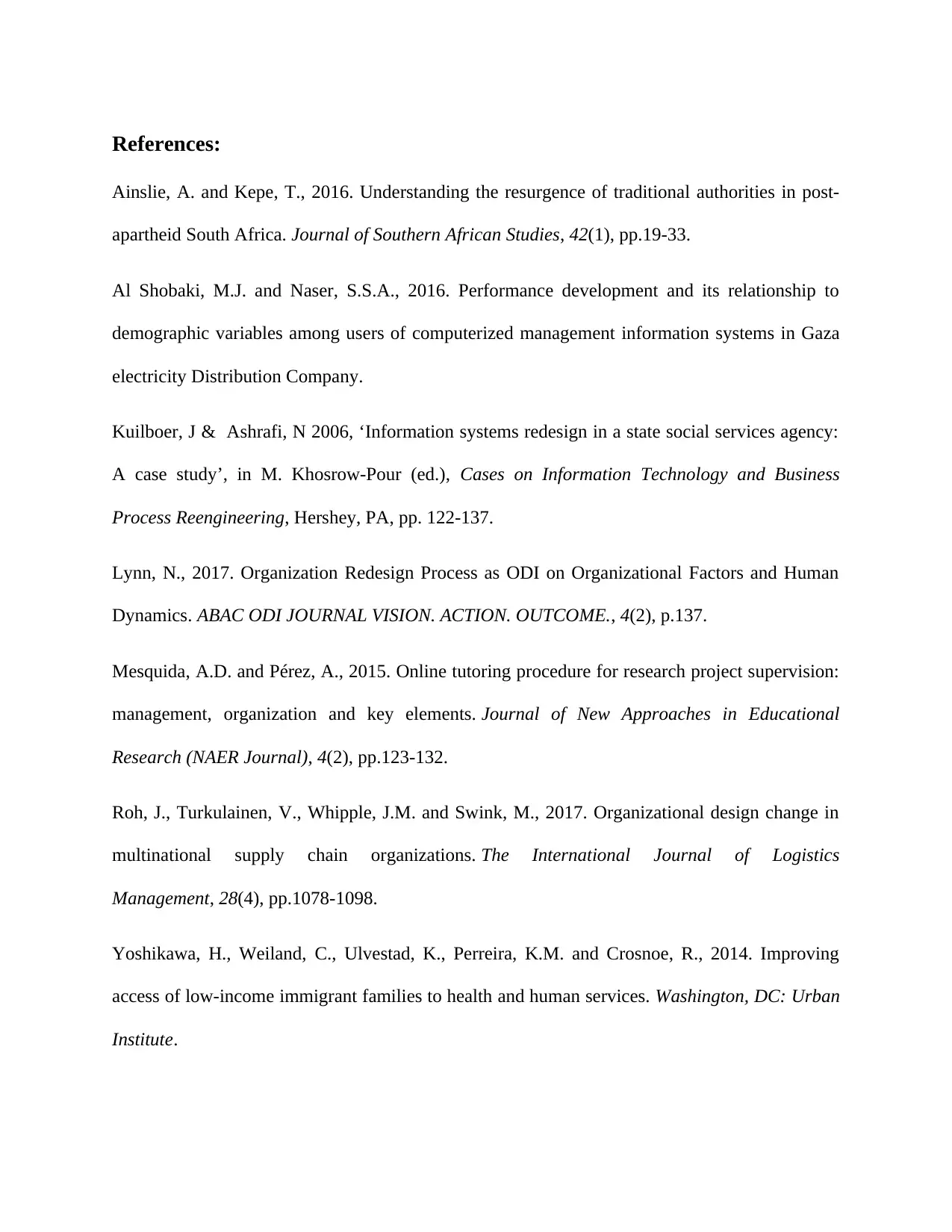
References:
Ainslie, A. and Kepe, T., 2016. Understanding the resurgence of traditional authorities in post-
apartheid South Africa. Journal of Southern African Studies, 42(1), pp.19-33.
Al Shobaki, M.J. and Naser, S.S.A., 2016. Performance development and its relationship to
demographic variables among users of computerized management information systems in Gaza
electricity Distribution Company.
Kuilboer, J & Ashrafi, N 2006, ‘Information systems redesign in a state social services agency:
A case study’, in M. Khosrow-Pour (ed.), Cases on Information Technology and Business
Process Reengineering, Hershey, PA, pp. 122-137.
Lynn, N., 2017. Organization Redesign Process as ODI on Organizational Factors and Human
Dynamics. ABAC ODI JOURNAL VISION. ACTION. OUTCOME., 4(2), p.137.
Mesquida, A.D. and Pérez, A., 2015. Online tutoring procedure for research project supervision:
management, organization and key elements. Journal of New Approaches in Educational
Research (NAER Journal), 4(2), pp.123-132.
Roh, J., Turkulainen, V., Whipple, J.M. and Swink, M., 2017. Organizational design change in
multinational supply chain organizations. The International Journal of Logistics
Management, 28(4), pp.1078-1098.
Yoshikawa, H., Weiland, C., Ulvestad, K., Perreira, K.M. and Crosnoe, R., 2014. Improving
access of low-income immigrant families to health and human services. Washington, DC: Urban
Institute.
Ainslie, A. and Kepe, T., 2016. Understanding the resurgence of traditional authorities in post-
apartheid South Africa. Journal of Southern African Studies, 42(1), pp.19-33.
Al Shobaki, M.J. and Naser, S.S.A., 2016. Performance development and its relationship to
demographic variables among users of computerized management information systems in Gaza
electricity Distribution Company.
Kuilboer, J & Ashrafi, N 2006, ‘Information systems redesign in a state social services agency:
A case study’, in M. Khosrow-Pour (ed.), Cases on Information Technology and Business
Process Reengineering, Hershey, PA, pp. 122-137.
Lynn, N., 2017. Organization Redesign Process as ODI on Organizational Factors and Human
Dynamics. ABAC ODI JOURNAL VISION. ACTION. OUTCOME., 4(2), p.137.
Mesquida, A.D. and Pérez, A., 2015. Online tutoring procedure for research project supervision:
management, organization and key elements. Journal of New Approaches in Educational
Research (NAER Journal), 4(2), pp.123-132.
Roh, J., Turkulainen, V., Whipple, J.M. and Swink, M., 2017. Organizational design change in
multinational supply chain organizations. The International Journal of Logistics
Management, 28(4), pp.1078-1098.
Yoshikawa, H., Weiland, C., Ulvestad, K., Perreira, K.M. and Crosnoe, R., 2014. Improving
access of low-income immigrant families to health and human services. Washington, DC: Urban
Institute.
Paraphrase This Document
Need a fresh take? Get an instant paraphrase of this document with our AI Paraphraser

1 out of 8
Related Documents
Your All-in-One AI-Powered Toolkit for Academic Success.
+13062052269
info@desklib.com
Available 24*7 on WhatsApp / Email
![[object Object]](/_next/static/media/star-bottom.7253800d.svg)
Unlock your academic potential
© 2024 | Zucol Services PVT LTD | All rights reserved.





